
ABOARD THE LITTORAL COMBAT SHIP USS KANSAS CITY, OFF THE COAST OF CALIFORNIA – The cavernous mission bay of USS Kansas City (LCS-22) was crafted to hold the Navy’s needs to find sea mines, fight swarm boats or interdict submarines – mission packages that have lagged the construction of the ships and plagued the Littoral Combat Ship program.
Now the LCS might be ready for a new mission – moving Marines across the Indo-Pacific.
As the U.S. Navy navigates a new era of strategic competition with China in a constrained fiscal environment, the service could turn to one of its pained ship programs to help perform the Marines Corps’ Expeditionary Advanced Based Operations (EABO) island-hopping campaign in the Pacific.
The Navy is considering the viability of using the Independence-class variant that is headed to the Pacific to move Marines around islands and archipelagos for EABO. Instead of containers filled with mission gear, Marines could pack into the mission bay below the flight deck of ships like Kansas City, as they head to islands to set up bases where they could fire anti-ship missiles.
“We’ve done EABO – the Expeditionary Advanced Basing Operations – just moving Marines and all that around. I mean, it’s not a new concept for the Navy. It’s just leveraging this platform to do it,” Rear Adm. Robert Nowakowski, the deputy commander of Navy Recruiting Command and Naval Education and Training Command Force Development who is currently leading a new effort called Task Force LCS, told reporters last month.
EABO, the radical rethinking of how the Marines will deploy in the near future, is predicated on small groups ranging across the Pacific islands, creating ad hoc bases and expeditionary nodes.
For example, the Marines have tested using MV-22B tilt rotors and KC-130s to build remote bases to refuel and rearm F-35B fighters. The Marines are also experimenting with a modified Joint Light Tactical Vehicle to lob anti-ship missiles from shore in a program known as NMESIS. The idea is to rely less on the Navy’s massive amphibious ships and more on air and smaller platforms and units to spread Marines around islands and shorelines.
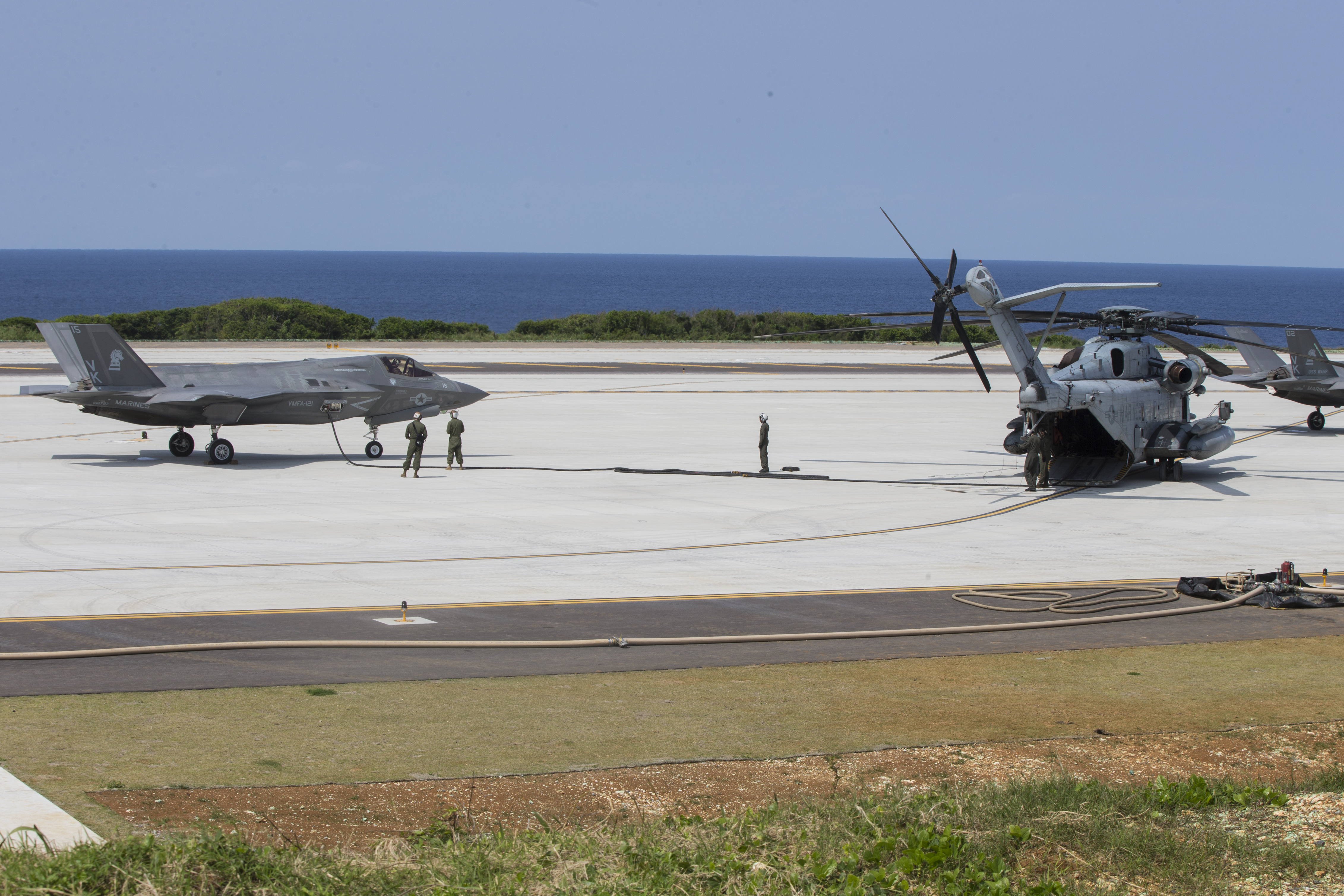
To that end, analysts and observers say the Navy should experiment with the concept of using the LCS to move Marines around the island chains, but note there are several limitations as to what the ship can do because of its size and design.
For example, the Independence-class boat launch is more than a dozen feet from the waterline and would require pier access to unload Marines and equipment.
The idea comes as the Navy looks for ways to employ the Littoral Combat Ships – which are now entering the fleet in high numbers – and the Marine Corps pursues a Light Amphibious Warship to shuttle Marines around the island chains. The Navy has struggled with the LCS mission packages – envisioned as a way to swap three different types of mission sets within the ship. But the service has only deployed an LCS with a version of the surface warfare mission package, as developing and fielding the anti-submarine warfare and mine countermeasure packages has been delayed.
“The LCS – the mission is not completely clear. And so I think the Navy is looking at this as a way to provide an additional mission for the LCS to do,” Hudson Institute senior fellow Bryan Clark, a former submariner who previously worked on the chief of naval operations staff, told USNI News.
“It would help the Navy get more value out of the LCS and make those deployments more impactful,” Clark added. “And then it would help them on the financial side because it would give them a way to mitigate that the LAW may be slow in coming or may not ever come at all.”
While the possibility of using the LCS to move Marines around the littorals is not new, the recent shift to a strategy focused on countering China and the Marine Corps’ emphasis on new operating concepts like EABO and Littoral Operations in a Contested Environment (LOCE) brings new urgency to an idea that has percolated throughout the Navy for years.
‘These Ships Are Fast’
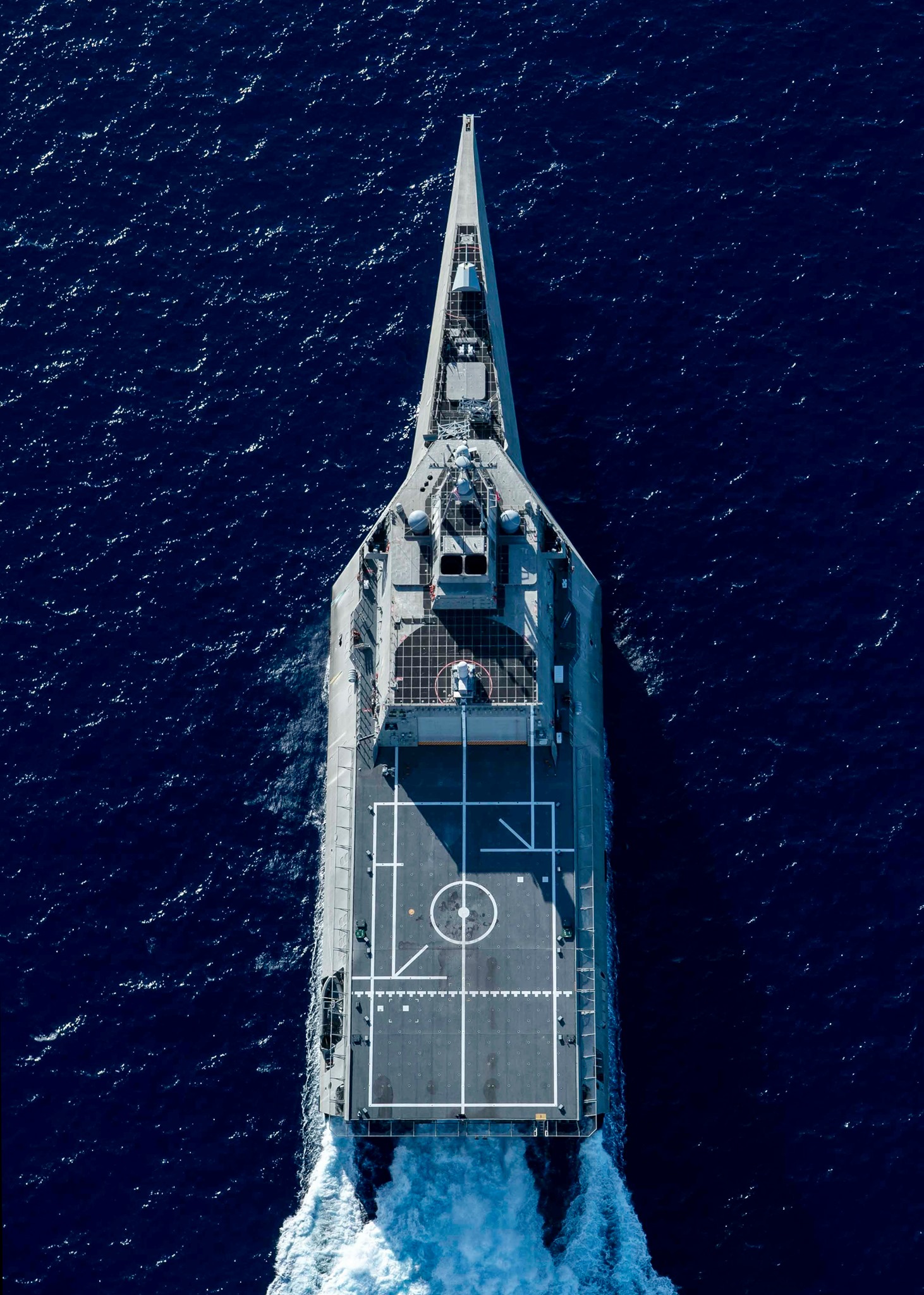
The idea of using the LCS to pitch in for EABO specifically applies to the Independence-variant, which has a large mission bay that experts say could house Marines. The Indy-class ships are also heading to the Pacific region and receiving priority for the Naval Strike Missile. Several Independence-class ships have deployed to the Indo-Pacific in the last year.
During a recent USNI News visit aboard Kansas City, Nowakowski touted the speed of the LCS – more than 40 knots – as one of its attributes that could help with the Marine Corps mission.
“I mean these ships are fast. And one of the options is to use these ships to transport between the island chain. Now, if you have missiles on these island chains and you have ships moving people between the island chain, that’s a whole other element of surprise, a whole other strategy, that throws a curveball to our adversary,” Nowakowski said.
“How do they know what we have specifically? We’re going to have stuff on the ships, but we’re also going to have stuff on the land. And we’re moving people around all the time – it’s hard for them to counter it,” he added. “And if they do counter it, they have to have more forces in order to counter it. So it just adds a whole other level of complexity and lethality to our national security.”
Bob Work, a former deputy secretary of defense and undersecretary of the Navy, said the Marine Corps could begin by experimenting with an Independence-class variant at Camp Pendleton, Calif., to get a better sense of how many Marines it could fit in the 338,000 cubic foot mission bay, what kind of housing equipment would be required, and how the Marines would conduct landing operations.
“Is it a reinforced company? Is it just a couple of platoons? What would it be? And they would practice loading it. They would practice sending the Marines out to sea for periods of time to make sure the ship would be able to support them,” Work, who is also the chair of the board of the U.S. Naval Institute, told USNI News.
“You start slow. You figure out how to make the platform and the Marines work together. Then, you take it to an exercise and demonstrate the capability,” he added. “And as soon as you’re satisfied that the capability is a good one, you go from exercise to operational deployment. So to me, this would not be a hard thing to do.”
Dakota Wood, a retired Marine who is now a senior fellow at the Heritage Foundation, first wrote about the possibility of embarking Marines on the Littoral Combat Ship in a 2008 paper for the Center for Strategic and Budgetary Assessments. While EABO and LOCE did not exist then, Wood’s paper at the time proposed embarking smaller units aboard a ship like the LCS and suggested that smaller units could be key in a potential conflict against China.
“As Gen. Berger looks at these widely distributed, small unit operations in a congested and contested maritime environment – among the littorals, near shipping channels, things that kind of characterize the South China Sea area, very archipelagic waters – he also realizes that he is budget limited. And so there’s just not a whole lot of money to develop lots of new platforms,” Wood told USNI News.
“So if the Navy has a smaller, very fast-moving ship that is able to carry small units, wouldn’t that be an ideal kind of a compromise or solution to a now problem, a current problem, that the Marine Corps has? And how do I logistically support and move small units within the Marine Corps in this EABO construct, or LOCE – the Littoral Operations in a Contested Environment? So in either one of those constructs, the LCS might be a readily available tool to enable those sorts of envisioned Marine Corps operations, at least for the time being.”

Wood also said the Marine Corps should experiment with the concept and use the Independence-class variant as a type of testbed.
“Can you use LCS with a good flight deck, a helicopter or two and enable the movement of small units to ship to shore and then repositioning those units to some other shore and do that very rapidly,” Wood said. “And it would seem at least for the present that this LCS would be a good prototype solution, or a good trial solution.”
Work pointed to the size of the mission bay on the Independence class as a reason why the ship is a good option.
“It’s not going to be comfortable for the Marines. I mean, what they would do is they would go into the [mission bay] and they would eat MREs. You’d have to have some running water so they could shave and you’d have to have extra heads, but it’s a great mission for the LCS. Moving the Marines around very very quickly,” Work said. “That’s a great use of the platform.”
An Interim Option
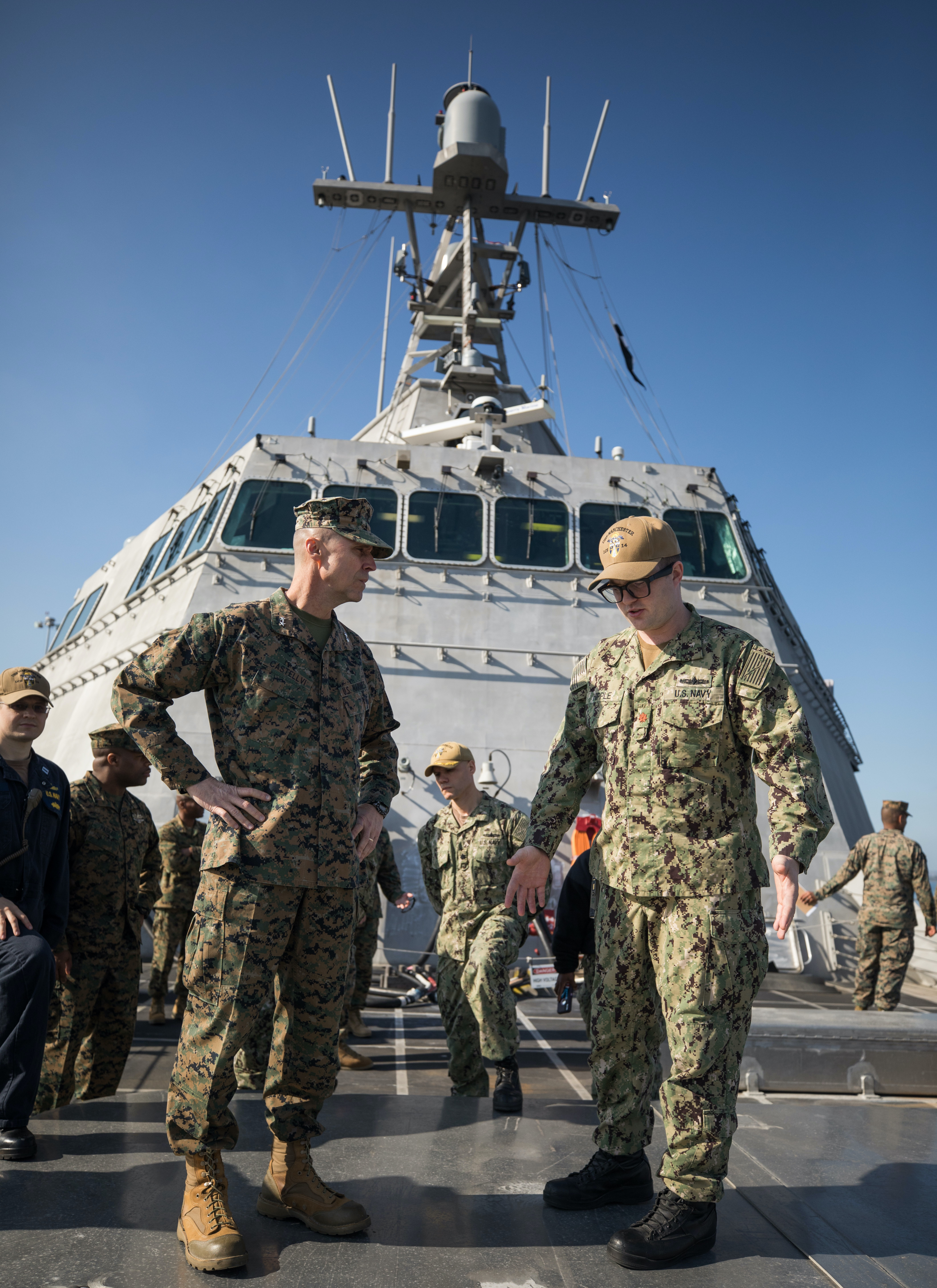
While experts see a future in testing the LCS to shuttle Marines, analysts also note limitations to how the ship could perform the mission because of the vessel’s size, design and habitability onboard.
Mark Cancian, a retired Marine who is a senior advisor at the Center for Strategic and International Studies, pointed out that the LCS has struggled to carry its own crew and suggested the configuration would not lend to carrying Marines.
“The LCS community is thrashing around trying to find ways to make themselves useful and it’s worth trying a lot of things. But those two – standard missiles and the Marines – look like real stretches,” Cancian said, referring to the Navy putting standard missiles on the LCS. The service is also assessing the viability of outfitting standard missiles on the ships.
“The space onboard the ship to put Marines, the difficulty getting them on and off, and the fact that they have other mechanisms like the” Expeditionary Fast Transport, are reasons why using the LCS to move Marines might not work, Cancian said. “Those would seem to be better aligned with EABO than LCS, frankly,” he added of the EPF.
The first deployed version of an LCS mission package featured accommodations for a Coast Guard law enforcement detachment that included crude racks nailed together inside a shipping container stowed in the mission bay of USS Freedom (LCS-1) in 2010.
Clark said the LCS would be better for shorter transits that are several hours long, as opposed to several days, because the mission bay space designed for cargo is not habitable for long periods of time.
“Even if you took the mission modules out and put in a habitability or just a seating or something in the mission bay … the Marines are thinking they want one to two hundred Marines on a Light Amphibious Warship and it may even be more than that. But if it’s one to two hundred people, you’re not getting that many people on an LCS. Or you’re not going to get them on there for anything longer than a few hours, maybe. So you’d be using it like a ferry,” Clark said.
Those potential shorter transits could occur in the Philippine or Indonesian archipelagos, Clark said, but a transit from one end of the Philippines to the other would likely be overnight.
“But you could do it in a pinch,” he added.
The Marine Corps planned to embark about 75 Marines on a Light Amphibious Warship to ferry them between islands, USNI News previously reported. To conduct EABO, Clark said the service is now looking at about 100 Marines aboard a ship that would take them to islands and shorelines so they could set up expeditionary bases.
“So in theory that might work, to use the LCS – especially if you’re doing it for a short transit between a couple of islands – because it would be something that offers more protection and survivability than the Light Amphibious Warship might,” Clark said. “And it also has additional weapons that the Light Amphibious Warship won’t, so it’s got surface-to-surface missiles. It’s got a helicopter. But the downside is you can’t dump them on the beach like you could with the Light Amphibious Warship and you can’t carry as many people for as long. So it’s really got to be just a short transit. It can’t be like a couple of days to go from one island to another.”
Clark estimated that 100 Marines in full gear could fit in the mission bay of the Independence-class ships.
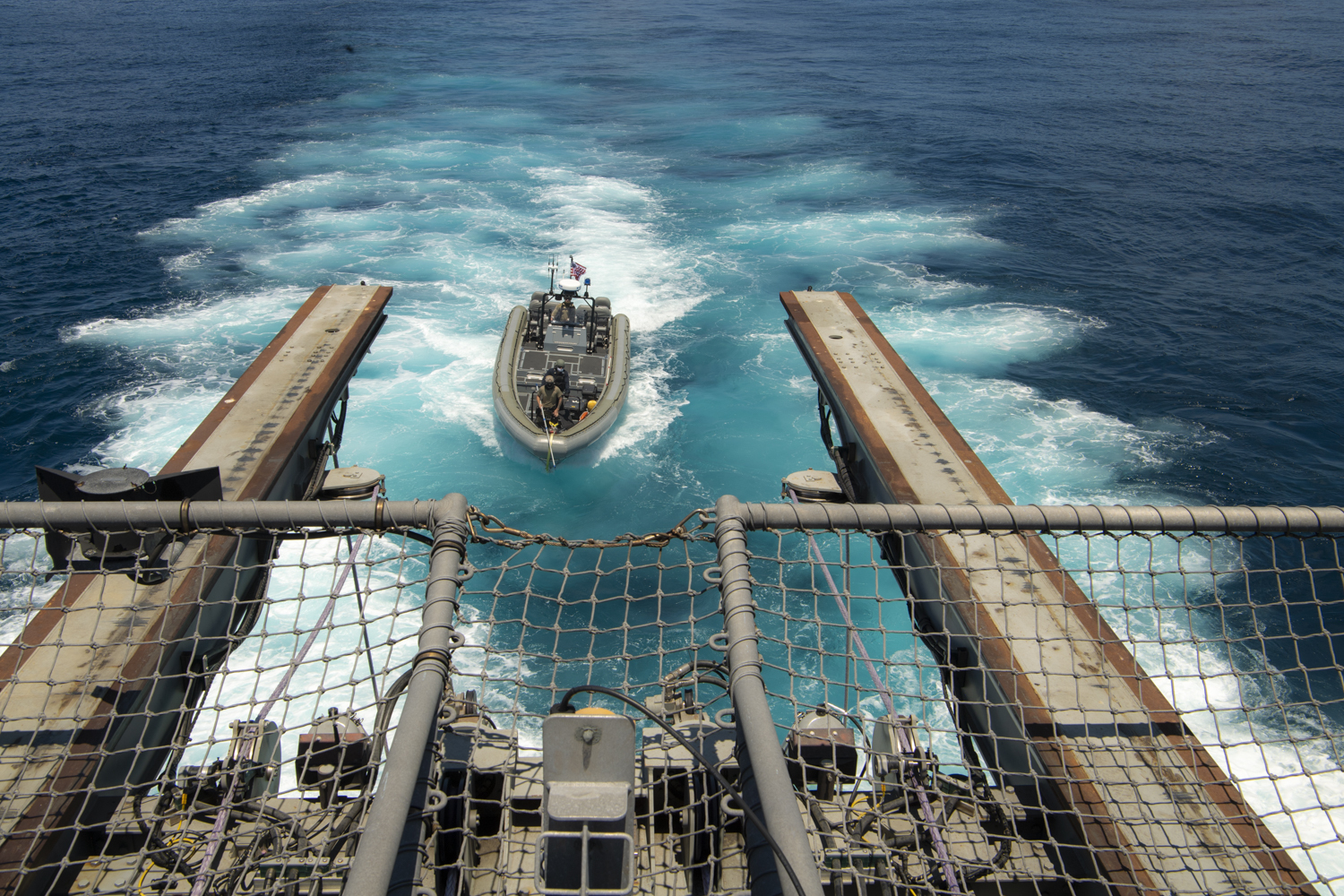
“Any increments smaller than like a hundred people, it’s not as effective, or it’s not useful as an [expeditionary advanced base]. So I do think that’s an option in the interim,” he said. “I do think it’s an option you could use in a pinch because in the mission bay you could certainly sit 100 Marines. And you could put some of their gear on the flight deck if you had to.”
But the LAW design would allow the ship to drive right up onto a beach to drop Marines, while the LCS needs to pull into a port or a pier, making its ability to drop Marines without detection difficult.
“The shortfalls – and the reason the Marines are still pushing for this Light Amphibious Warship – are that the LCS, it can’t drive up on the beach. It’s got a shallow draft, but to offload the Marines, you really have to pull up to a pier of some kind. Or, if you’re going to send them ashore in boats … you can certainly send boats over the side of the LCS, but it’s not really designed for that, so it’s a slow process,” Clark said.
But the LCS could be an alternative to move Marines while the Marine Corps pursues LAW.
“This is a good way to mitigate the risk. So if you start experimenting with LCS – it’s already in theater, it’s already going to go to the South China Sea. This is already part of its scheme. And then you just maybe offload the mission equipment in Singapore and then do this for a while, it gives you more capacity,” Clark said.
“So if you do get the LAW and you only get half the LAWs you thought you were going to get, well then you got LCSs to do part of that job too.”
‘Mother Ship’
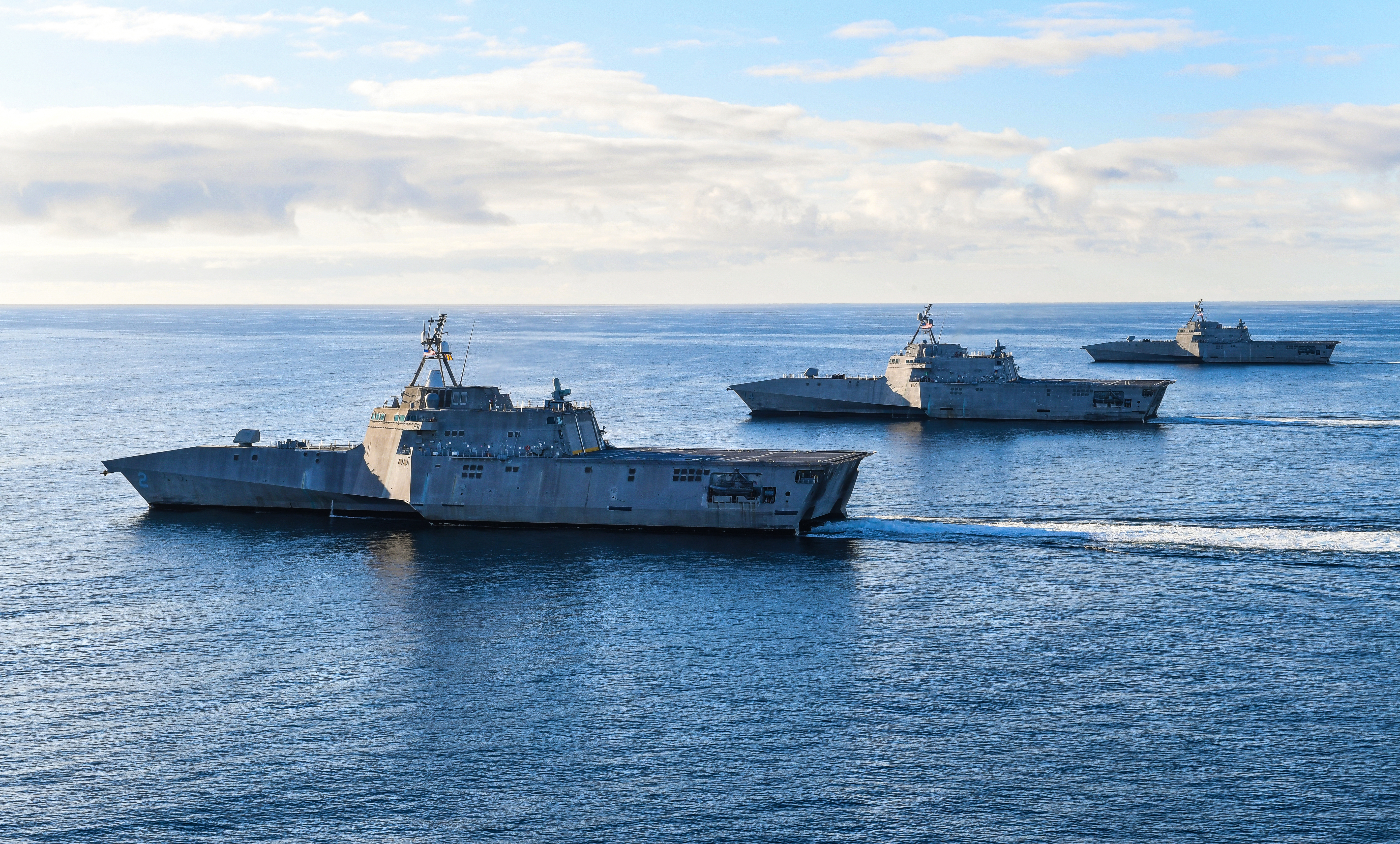
In addition to potentially using the LCS to ferry Marines around the islands chains, experts proposed other options for the ship.
“No matter what, I could see the LCS being the escort for the LAW and for the next-generation logistics ship. And the LCS is perfectly suited for this,” Work said, referring to the other ship the Navy and Marine Corps want for small unit operations. “[LCS] doesn’t have a lot of armament, but it’s got the 57 [mm gun] and it’s got the long-bows. It’s got an armed helicopter. So it would be able to provide some measure of escort for these other vessels.”
Clark, who has performed analysis of the naval fleet architecture for the Navy and Pentagon, suggested the amphibious transport docks could act as a hub for ships like the LAW and potentially the LCS.
“We were finding that the LPD’s role ends up being kind of as mother ship to the LAWs, or in this case the LAWs and the LCSs because it’s got … a lot of Marines will be on there. It’s got all the command and control. It’s got the welldeck and everything,” he said. “So you could see a situation where that LPD becomes the thing that puts Marines onto LAWs or to LCS and then sends them ashore and then is out there so they can come out and periodically reset while they’re doing EABO.”





